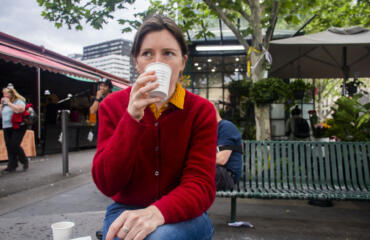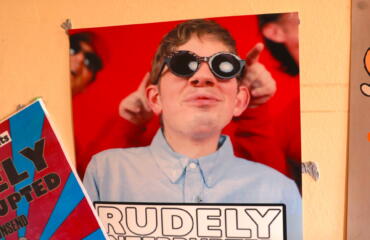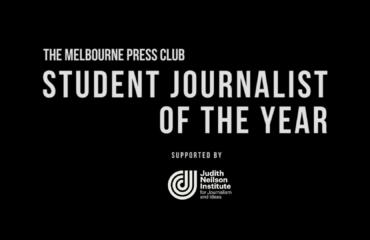
The #creatediversity campaign was launched last August by the Equity Diversity Committee of the union Actors Equity, calling on writers to encourage diverse casting for roles that don’t explicitly call for a certain ethnicity or cultural background.
So far, 120 writers have signed the pledge.
Screenwriter Mary Rachel Brown has been placing a notice at the end of her character lists that reads: “The author encourages casting that reflects diversity in Australian society.”
“Drama schools have graduated diverse cohorts for a long time. However, those actors don’t often get the opportunity to audition for — let alone be cast in — professional jobs that allow them to develop their craft over time.” — Pearl Tan, actor and director
“It encourages the reader to reflect and hopefully take some agency on the issue,” says Ms Brown, who has written for numerous programs such as the television show Home and Away and the play Last Letters. “It also holds me to account.
“In many respects, writers and producers have a responsibility to take a lead on this issue by creating content that reflects diversity. It’s important because the content of our writing has the potential to lead change.”
The #creatediversity campaign mirrors a similar push for diversity in Hollywood, which escalated during this year’s Academy Awards ceremony with social media abuzz with the hashtag #OscarsSoWhite.
“The #OscarsSoWhite campaign is brilliant as it shines a strong spotlight on this issue,” says Pearl Tan, director of Pearly Productions and co-chairwoman of the actors’ Equity Diversity Committee.
“Australia is heavily influenced by US pop culture. Popular images become symbols that people identify with, so diversity in the US means that Australians from diverse backgrounds can see themselves represented in art, even though it isn’t Australian, and this is important.”
According to Ms Tan, the problem isn’t a lack of actors from diverse backgrounds but the way roles are cast and the lack of opportunity for minorities.

“Drama schools have graduated diverse cohorts for a long time. However, those actors don’t often get the opportunity to audition for — let alone be cast in — professional jobs that allow them to develop their craft over time. Yes, it is difficult to carve out a career as an actor regardless of your background, but it is especially challenging for those from diverse backgrounds.”
Local theatres are also trying to improve their casting strategies by explicitly encouraging minorities to audition for roles.
“I think it’s important for major arts organisations to really show that we are open to everyone,” says Bell Shakespeare associate director James Evans. “Too often actors might think, ‘That job isn’t for me’ or ‘I don’t really fit into a certain mould’, whereas we want to throw those doors wide open and make sure we are casting as diversely as we can.”

Last year, Bell Shakespeare’s casting notice for its touring acting ensemble The Players specifically encouraged applicants from diverse backgrounds to apply. The result was “a big bump in our applications from actors from diverse backgrounds, and all actors,” according to Mr Evans.
Although Shakespeare’s plays were written more than 400 years ago, Mr Evans believes today’s Shakespearean productions can benefit from diverse casting.
“Look at how diverse our audience is . . . We need to be reflecting them, we need to be telling everyone’s stories. And especially with Shakespeare. Somehow, his work transcends culture, transcends time, and is for absolutely everyone. And we need to take the lead in reflecting that onstage.”
Not-for-profit Carlton-based contemporary theatre La Mama also encourages “diversity in all its guises”, according to chief executive Liz Jones. “I think it’s very important to make sure that all the lines of communication are open, and that the door is always open to people that speak languages other than English.”
According to the last Census, in 2011, almost a quarter of Australia’s population was born overseas, with 43 per cent of Australians having at least one overseas-born parent. This is in stark contrast with the ethnic makeup of television and film roles. But despite the recent social push for more diversity, statistics are hard to pin down.
“Look at how diverse our audience is . . . We need to be reflecting them, we need to be telling everyone’s stories. And especially with Shakespeare. Somehow, his work transcends culture, transcends time, and is for absolutely everyone.” — Bell Shakespeare associate director James Evans
Two weeks ago, Screen Australia announced that it was exploring how cultural diversity, disability and the LGBTQI community were being represented in Australian television. Its research will analyse Australian dramas (adult and live-action children’s TV dramas, including comedy) that were broadcast from 2011 to 2015 on commercial free-to-air networks, public broadcasters and subscription channels.
According to Ms Tan, Screen Australia’s research will help “put effective strategies in place to incentivise more diversity and inclusivity on our screens.”
To address the lack of available data, Ms Tan is also designing a measurement tool for the live theatre sector, to be able to measure diversity and inclusivity in their casting. “This tool will bring some consistency to the area, across different theatre companies, and help us to get a baseline so we can truly track changes in Australian storytelling alongside audience preferences.”
Ms Tan’s process is inspired by the Global Reporting Initiative, which advises governments and businesses on measuring sustainability with almost 23,000 registered reports from almost 9000 organisations. It breaks down diversity into seven different categories: ethnicity, gender (including non-binary categories), age, sexuality, disability, religion and socio-economic background.
Ms Tan hopes that her yardstick “will be a standardised way for theatre companies to measure themselves year-to-year, season-to-season and show-to-show.
“It will allow companies to benchmark themselves against the rest of the industry and collaborate to reveal changes in audience preferences over time. It will encourage those using the tool to look at the wider scope of diversity and see the opportunities in audience development areas for the economic, social and cultural betterment of Australian storytelling.”

Malthouse Theatre artistic director Matthew Luton agrees that onstage diversity is important, “if we want our stages to be a place that honestly reflects our country’s aspirations and diversity.”
However, he thinks that society needs time to adjust to the new expectations.
“It won’t happen in three years; it will probably take up to a decade for the culture to shift, and will require persistence, resilience and risk taking.”
No matter how long the cultural shift may take, Ms Tan thinks change is essential for today’s artists.
“There needs to be affirmative action and systemic change in order to ensure the storytellers of tomorrow aren’t as boring!” she says, pointing to the Australia Council’s case study report from late last year as encapsulating her argument.
It concluded: “Diversity should be seen as an asset, not a liability, for both individuals and societies. Cultural diversity is now seen as an essential requirement of sustainable development, because a world where diversity flourishes increases the range of choices for people and communities, thus nurturing their capacities for creativity and innovation.”



